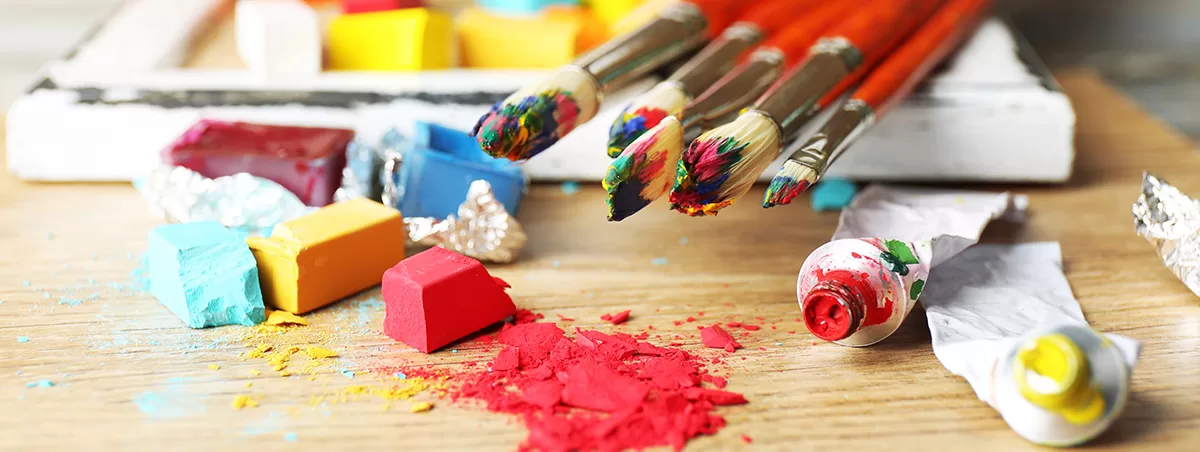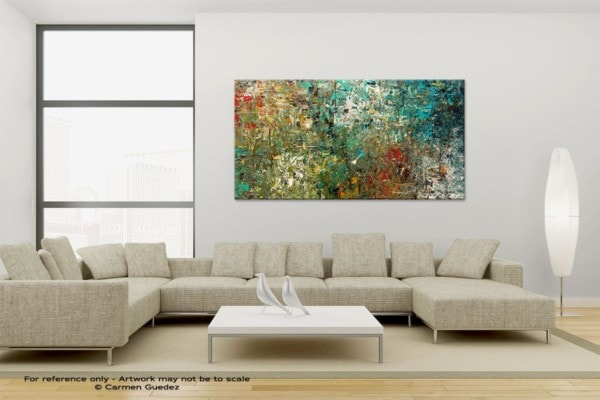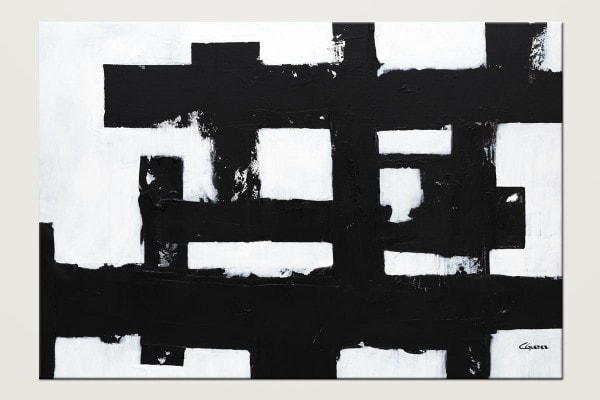The Ultimate Guide to Abstract Art: 35 FAQs on Buying, Selling, and Understanding Abstract Paintings
While abstract art is extremely popular, most people still have a lot of questions about this form of art. Below is a complete guide to buying, selling, and understanding abstract paintings. We’ll dive into the elements and characteristics of abstract art, so you can get an idea of how to understand these works. We’ll address some concerns that art lovers and artists may have, and you’ll also discover all about the most important abstract painters who paved the way for people working in the field today!
Whether you are looking to create abstract art, buy it for your home, or simply appreciate all it has to offer — this is your ultimate guide.
Below, you’ll find answers to the most common questions about this often brilliant, sometimes mysterious movement. Some of the concepts might be new to you, but by the end, you’ll have a great foundation to understand the world of abstract art.
The Basics of Abstract Painting
1. What is abstract art?
Abstract art is work that doesn’t represent something in the real world. It relies on the building blocks of color, line, shape, value, texture, and form. Read a more in-depth explanation with examples in What Is Abstract Art? Definition & Examples of Famous Abstract Paintings.
2. Are there four types of abstract painting?
Many art critics will classify abstract paintings into four types:
- geometric abstraction
- lyrical abstraction
- color field painting
- abstract expressionism
Each type uses abstraction differently. It could emphasize geometry, play with the lyrical or emotional value of a piece, display color fields to celebrate the energy of different colors, or use the infinite possibilities to express inner states.
Many abstract artists will dabble in more than one type, and some of their works might borrow from more than one approach to reach the final destination. So while these categories can be a helpful place to start, they are rarely the whole story.
3. Why do people make abstract art?
People make abstract art to create emotional and/or intellectual experiences for the viewer through images that don’t represent reality, to express feelings, ideas, and experiences, or to make a point or a statement.
Because it is unconnected to the physical world, abstract art is a thrilling way to create. The artist has so much freedom to explore anything that comes to their mind. They might also have things they want to express that simply can’t be said through ordinary representational methods.
It’s important to remember that this form of painting has a history tens of thousands of years old — and there’s evidence Neanderthals even made abstract art!
People have been making images that don’t relate to the visible world almost since we were making images at all. That speaks to some deep, primal desire in us to create abstract art.
4. What are three important features of abstract art?
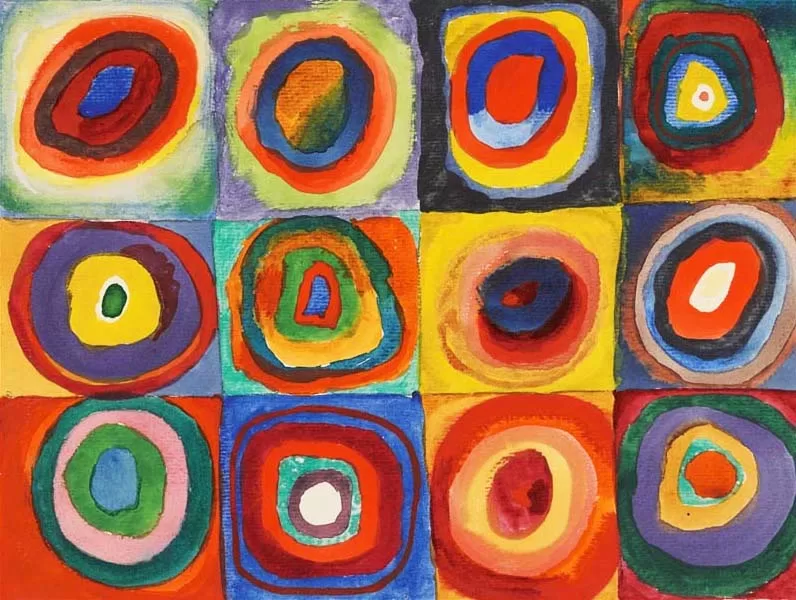
Color Study, Squares with Concentric Circles by V. Kandinsky [Courtesy of Wikimedia]
Abstract art is often judged based on three characteristics. They should be:
-
- non-representational
- spontaneous
- subjective
These characteristics allow for a wide range of interpretation and emotional response from the viewer. When a work is non-representational, it doesn’t try to present the viewer with an image of the real world. You could say that’s the heart of abstraction.
A spontaneous work isn’t necessarily unplanned or made on the spot. Instead, the term means that the piece contains surprise or mystery. In other words, the viewer discovers more about the painting the more time and attention they give it.
Finally, if a painting is highly subjective, it shows us a strong viewpoint. That helps viewers transcend their own perspectives.
Of course, there are many ways that artists break from these demands and still wind up with beautiful pieces. But, as with the types of abstract paintings we covered above, these metrics help us to start appreciating works we see. If you are struggling to understand abstract art , start asking how it uses its non-representation, spontaneity, and subjectivity.
5. Are there six elements of abstract art?
Many art critics boil down the essentials of visual art to these six elements:
- line
- color
- shape
- form
- value
- texture
These elements can be used in various combinations to create abstract art, though not every painting will emphasize all six prominently. There is also plenty of debate about these elements between artists and their audience. Like so much in art, reality is more complex than a simple set of rules. But these six elements are a great place to begin considering a work of abstract art or making one yourself.
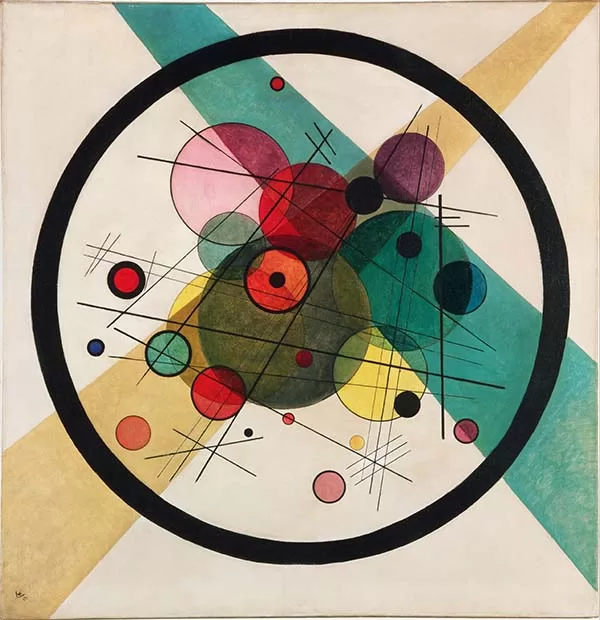
Circles in a Circle by Kandinsky [Courtesy of Philadelphia Museum of Art]
6. Can anything be considered an abstract painting?
Any painting that isn’t trying to represent external reality could be considered abstract.
This might include a wide range of artistic works throughout human history, like:
-
- certain cave paintings that are a series of non-representational marks
- many Aboriginal designs
- geometric patterns by Muslim artists
- design motifs used in Navajo art
- and much, much more!
Sometimes paintings depict real world subject matter but in such an “unrealistic” way that it becomes abstract. In Birsk (pictured below) Liubov Popova shows us a cityscape — but it’s been so removed from direct representation that the painting becomes enjoyable for the basic elements of it as an image. What are those elements? We’ll cover that in the next question.

Birsk by Liubov Popova [Courtesy of The Guggenheim Museum]
History of Abstract Art
7. What were the three forms of art that led to abstract painting?
Abstract painting arose from the influence of three art movements:
-
- Cubism
- Futurism
- Expressionism
These styles emerged in the early 20th century and helped to define abstract art with their groundbreaking approaches to painting. With each movement, artists stepped further and further away from the strict adherence to realistically portraying the world that had dominated Western art for millennia.
Cubism moved away from traditional methods of perspective, presenting views of their subjects that did not reflect how we see the world.
Futurism captured the energy and speed in the industrializing world by breaking down realism into geometric building blocks. (Unfamiliar with this movement? Check out the painting below!)
Expressionism focused on changing the way the world was painted to tell the viewer something about an interior state.
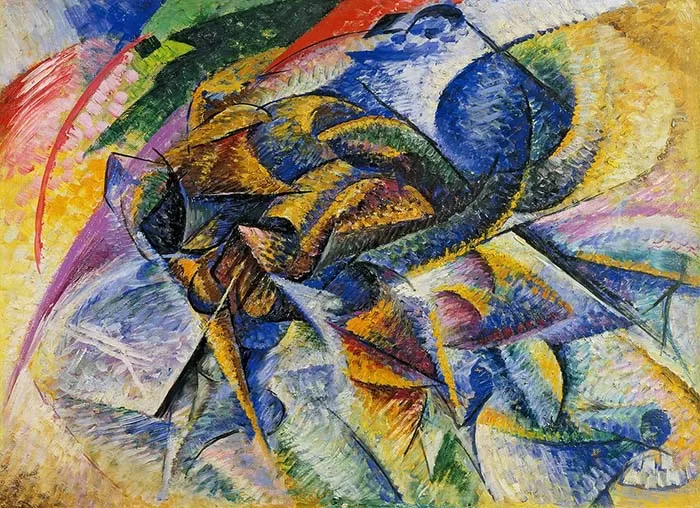
Dynamism of a Cyclist (Dinamismo di un ciclista) by U. Boccioni [Courtesy of Wikipedia]
8. Who are the most famous abstract painters?
The most famous abstract artists include Jackson Pollock, Wassily Kandinsky, Mark Rothko, Piet Mondrian, and Kazimir Malevich.
But there are many, many more who went on to become famous throughout the 20th and 21st centuries. Also, there are a wide range of representational painters who learned and borrowed a great deal from their peers in abstract art, like Georgia O’Keeffe.
While they are often not as credited at the time, many women artists were pivotal in the creation of abstract art. Many historians now point to the work of Hilma af Klint as possibly the first truly abstract artist in the Western world.
9. What are the most famous abstract paintings of all time?
Of all the abstract paintings, perhaps the most famous are Broadway Boogie Woogie (1943) by Piet Mondrian and Black Square (1915) by Kazimir Malevich.
Other extremely popular examples of abstract paintings are:
-
- Violet, Black, Orange, Yellow on White and Red (1949) by Mark Rothko
- Number One (1950) by Jackson Pollock
- Convergence (1952) by Jackson Pollock
- Broadway Boogie Woogie (1942-43) by Piet Mondrian
- 5 (1948) by Mark Rothko
- Mountains and Sea (1952) by Helen Frankenthaler
- Composition VII (1913) by Wassily Kandinsky
- Who’s Afraid of Red, Yellow and Blue (series of four painted between 1966-1970) by Barnett Newman

Broadway Boogie Woogie by Piet Mondrian [Courtesy of Wikipedia]
10. What is the most expensive work of abstract art ever?
Willem de Kooning’s 1955 masterpiece Interchange is the most expensive work of abstract art ever sold. It went for $300 million in 2015.
That makes Interchange far and away the most expensive work of abstract art ever.
The sale was between the David Geffen Foundation and the buyer Kenneth C. Griffin. In the same transaction, Griffin bought Number 17A (1948) by Jackson Pollock for $200 million.
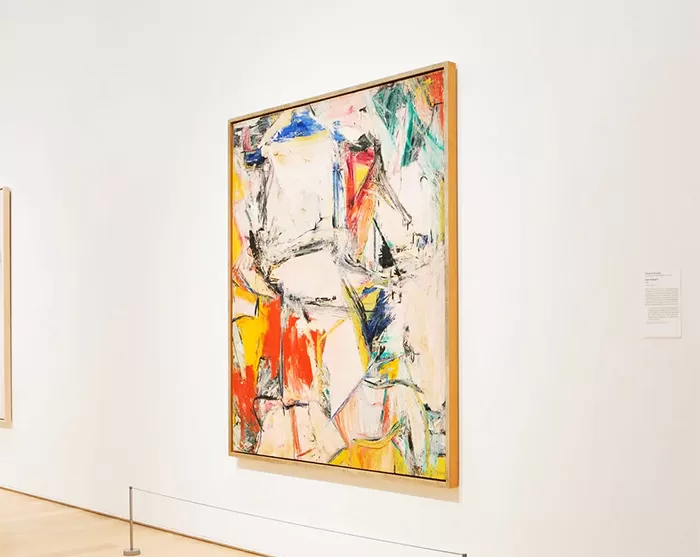
Interchange by W. de Kooning [Courtesy of The New York Times]
11. What is the definition of Modern Abstract Art?
Modern abstract art includes all non-representational art produced during the modern art period — the late 19th to the mid-20th century.
You might have noticed that in everyday language, most people use the word “modern” to mean new, but not in the art world! For things going on right now, we typically say “contemporary.”
As for contemporary abstract art, it is going through a major transition. A major part of this is the use of artificial intelligence to create abstract art. Want to learn more about this contemporary form? check out The Art of Artificial Intelligence: AI History, Pros & Cons of AI, Types of AI Generators and Copyright.
As we’ll see in the next question, modernity as an era left an indelible mark on the abstract.
12. What’s the difference between abstract art and contemporary art?
Abstract art includes all art that doesn’t try to represent things in the real world. Contemporary art refers to any art produced in the present.
So abstract art made by artists today is contemporary art, but not all contemporary art is abstract.
Contemporary art is more and more coming to be defined for the way artists are blurring the lines between different genres, producing hybrid works that make us consider critical issues in society and rethink the way we see art as a human endeavor.
13. Who are the most famous contemporary and modern abstract artists?
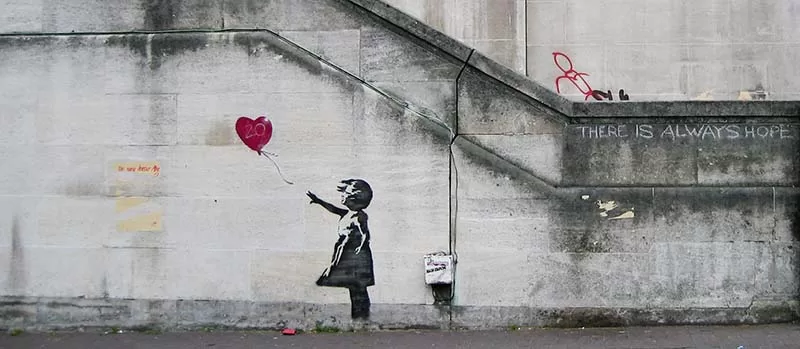
Girl with Balloon by Banksy [Courtesy of Dominic Robinson and Wikipedia]
Contemporary abstract artists admired by many people are: Jean-Michel Basquiat, Damien Hirst, Jeff Koons, Mark Bradford, Takashi Murakami, Andy Warhol, Roy Lichtenstein, and Banksy.
The most famous modern abstract artists include Jackson Pollock, Mark Rothko, and Wassily Kandinsky.
These remain extremely popular abstract artists up to the present day. That’s because the modern era saw the rise of abstraction as a force in the art world, and so many of the masters who worked in the field at that time now enjoy the status of pioneers who did many things for the first time.
Buying and Investing in Abstract Paintings
14. Why is abstract art so popular?
Many people like abstract art for a variety of reasons, including:
-
- It can be aesthetically pleasing.
- It can evoke strong emotions.
- It means freedom of expression.
- It is subjective and open to interpretation.
- It is adaptable to almost any décor.
Abstract art is sure to be one of the most revolutionary, fascinating, and wide-ranging fields in art.
15. Should you invest in abstract art?
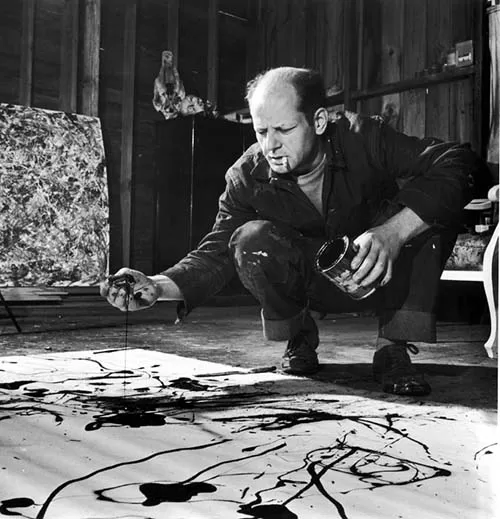
Jackson Pollock [Courtesy of Sotheby’s]
If a work of abstract art is made by an artist with an established track record and strong reputation, it might be a great investment.
You should always remember that investing inherently contains risk. But when you buy a piece that you personally connect with, you get to take it home and enjoy it for years while it potentially goes up in value. That makes it a much more fun way to invest than most other assets.
16. How much money is abstract art worth?
Abstract art can be worth a significant amount of money if created by a renowned artist or is attractive enough to a buyer.
The value of abstract art is subjective and depends on various factors such as the artist, medium, size, and complexity of the artwork. It’s the same with all art — the price is heavily determined by how much a buyer is willing to pay.
17. Why do abstract paintings cost so much?
Abstract paintings can be expensive due to the time, skill, and materials required to create them.
Additionally, the reputation and demand for the artist can also influence the price.
Many painters train for years to hone their abilities and become effective communicators through form, line, color, composition, and rhythm alone. That dedication pays off when they are able to realize high prices for their paintings.
But, of course, not all abstract paintings are expensive. And as you’ll see in the next several questions, there are ways to find more affordable work.
18. Where can I buy affordable abstract art?
If you are looking for affordable abstract art, consider shopping at:
-
- CgModernArt
- Etsy
- Target
- Overstock
- Wayfair
These are all great places to find abstract art that won’t break the bank. They offer a variety of options that cater to different tastes and budgets, and they get you headed in the right direction.
You can also try finding young artists in your area who are just starting out for original abstract art. Their prices will be lower, and when you buy from them, you’ll be directly supporting a budding career!
19. What is a print of an abstract painting?
A print is a reproduction of an original painting, created using a variety of techniques. These are typically much more affordable than original paintings.
Prints are a great way to get started collecting artwork because they are less expensive and easier to take care of than original works. And the quality of prints improves all the time.
For more information on the difference between prints and original paintings, see Print vs. Original Painting.
20. Are prints less expensive than original paintings?
Yes, prints are almost always less expensive than paintings. Artists are able to make many copies, so they can make each print available at lower price points.
Paintings, on the other hand, are one-of-a-kind pieces, which greatly increases their price. Once an artist sells an original painting, it’s gone forever.
21. How can I tell if a painting is an original or a print?
Figuring out if a work of art is an original or a print can take careful observation. Look for brushstrokes or texture on the canvas, indicating an original.
Prints typically appear flat and lack the texture of an original painting. Sometimes a little bit of texture will be added on after printing, but it will be clear that all of the image was not painted by hand.
You can also look for a signature or edition number, as prints are often numbered and signed by the artist.
22. Where do I buy large abstract wall art?
You can buy large abstract wall art from artist websites, direct commissions from artists, local galleries, art fairs, and online marketplaces.
There’s never been so many options to buy large abstract paintings. If you really want to expand your horizons and discover artists to buy from, consider browsing places like Instagram where you can connect directly with creators you love.
Something to remember about buying large art of any kind is that you need to safely transport it to wherever you want to hang it. If you are looking to get an enormous painting into your living room (see below), you’ll need to make sure it can actually fit through the door. You might also need to invest in special transportation.
23. Is there a best size for abstract painting?
The best size for abstract paintings always depends on personal preference and where you want to display it.
A large painting has the ability to fill up a room and start conversations, while smaller paintings give people a chance to discover them and have a more private moment with the work. What you are looking to add to a given room will determine what size matches those needs.
Also, consider the space where the painting will be hung and choose a size that complements the room’s dimensions and décor. You don’t want a painting way too big or too small for the space.
Huge Large Abstract Art Painting Discovery
24. What is the best abstract art for living rooms?
Living rooms tend to work well with abstract art featuring warm colors and organic shapes.
While those are good guidelines to start with, every living room is different. The color scheme, overall decor, and architecture works together to produce the vibe you are looking for. Take care to balance the size of the painting with the other elements in the space, and consider how the shapes and texture of the work play off of the room as a whole.
If you have very specific needs and can’t find something that fits, consider getting a custom painting created for your living room!
Selling Paintings as an Abstract Artist
25. Are people buying abstract art?
Yes! Art buyers turn to abstract art for various reasons, such as aesthetic appeal, investment purposes, and personal connection to the artwork.
Art lovers are perennially attracted to the diverse contexts that abstract art can thrive in. And because of its versatility, this is an extremely popular and practical genre of painting to purchase. Check out some of the Best Selling Abstract Art Paintings.
26. What kind of abstract paintings sell the most?
Many buyers are looking for paintings that are large, unique, colorful, or just black and white.
While these paintings tend to sell the most, there are always exceptions. Nevertheless, people are usually buying art to hang in the places they live and work — which means they usually want it to make them feel good when they see it.
Trends can veer off in any direction, but works that are visually striking, emotionally impactful, and unique tend to have a better chance of selling no matter what’s popular. That’s because these works immediately grab the attention of potential buyers.
That being said, chasing trends is not a great way to build your name in the long run. Working to paint work that expresses your point of view will allow you to connect with an audience over time, regardless of what size, colors, or approaches you use.
Abstract Art in Black and White Straightforward
27. Can abstract paintings sell well?
Yes, abstract paintings can sell well, especially if they are well-executed and appeal to buyers’ tastes and preferences.
Marketing and exposure can also play a role in the success of selling abstract paintings. It comes down to building a relationship with art buyers — creating a website, email newsletter, and/or social media presence can help.
Making money painting abstract art is not a get rich quick scheme by any means, and you’ll only find success through dedication. Even then, there is no guarantee of success.
28. Is being an abstract artist profitable?
Making abstract art can be profitable if you develop a reputation and demand for your work. Similarly, smart buying makes investing in abstract art profitable.
But profitability can also depend on market trends and buyer preferences, two things that are out of your control. For that reason, it’s most important that you actually enjoy abstract art to begin with. That way, no matter how much money it makes you, the experience will be worth it.
Making money in abstract art requires making a connection to potential buyers. That means you need to create good work in the studio and market it diligently.
Many artists find making money easier now than ever before. The internet has opened the door to many people who would traditionally have a difficult time breaking into the market. Now, you don’t have to live in a major hub to have access to art buyers from around the world!
Large Abstract Painting Blue Ocean
29. How to price an abstract painting?
Price your abstract painting based on the cost of your materials, how strong your name recognition is, and similar work in your area.
Pricing an abstract painting can be challenging, but factors to consider include:
-
- size
- materials
- complexity of the painting
- name recognition of the artist
- how close the style of the painting matches the most famous works by the artist
If you are looking to price your own work, research the prices of similar paintings by other artists and factor in your level of experience and reputation. It’s also a good idea to check out similar artists selling in the same area as you, which will give you a hint to the price tolerance of the local market.
30. Should you frame abstract paintings?
Framing an abstract painting depends on the artist’s preference, the buyer’s preference, and the place you are planning to display it.
Some artists prefer to leave their paintings unframed to showcase the texture and depth of the canvas, and some paintings even use the edge of the canvas to continue the image. In these cases, going without a frame is best.
If you are going to frame your piece, always be sure to use proper methods of handling.
Abstract art enjoys a strong market both online and offline.
Abstract art has gained popularity in recent years and attracts collectors and buyers from all over the world. It is also a favorite genre among interior designers, giving it a solid foundation of interest.
Getting representation from a gallery or having an agent that puts your artwork in the hands of buyers is still a great route. But today, more and more art buying and selling takes place online. So, let’s look at the exact places you can sell your work on the internet in our next question.
31. What’s the market for abstract paintings?
Abstract art enjoys a strong market both online and offline.
Abstract art has gained popularity in recent years and attracts collectors and buyers from all over the world. It is also a favorite genre among interior designers, giving it a solid foundation of interest.
Getting representation from a gallery or having an agent that puts your artwork in the hands of buyers is still a great route. But today, more and more art buying and selling takes place online. So let’s look at the exact places you can sell your work on the internet in our next question.
32. Where should you sell original abstract art online?
The internet provides artists many places to sell their original abstract art online. Each site will give you access to a particular group of buyers.
Your options include platforms such as:
-
- Saatchi Art
- Etsy
- CgModernArt
- Fine Art America
- Ebay
These platforms provide exposure to a wider audience and allow artists to connect with potential buyers from all over the world.
You can also build your own website where you sell to buyers directly. This can work if you are willing to put the time and effort into developing your brand and promoting your online store. If you do go this route, you’ll probably want to maintain a presence on other platforms for a long time. People go to websites like Etsy and Fine Art America to search for art — so it’s a good idea to be there!
Making Abstract Art
33. Why is abstract painting difficult to do?
Artists may find abstract painting difficult since it requires you to break away from traditional techniques and create an entirely unique visual language.
While it can be liberating to create anything you want using the basic building blocks of color, line, texture, and form — this can also be daunting! Artists who are used to having recognizable subject matter to convey emotions will definitely take some time to get used to this new approach.
But it’s always worth it to try!
34. What is the best paint for large abstract art?
Most abstract painters prefer acrylic paint because it dries quickly, is easy to mix, and can be used on various surfaces.
Some acrylic paints are also fairly inexpensive, making it a great option for large format paintings.
But of course, the answer to the question changes from artist to artist. Some swear by oils, while others use paints that aren’t traditionally associated with fine art — like house paint. As with anything in abstract art, experimentation is key.
Some artists, like Carmen Guedez, use mixed media on their canvas paintings, such as acrylic paints, pencils, pastels, and oil mediums.
35. What are ideas for abstract paintings?
You can explore a variety of ideas for abstract paintings, including:
-
- patterns
- color relationships
- pouring paint
- dripping paint
- splattering paint
If you have an abstract painting you particularly admire, a good place to start is by recreating it. Through this process, feel free to start making changes based on your own intuition. Pretty soon, you’ll notice yourself getting lost in the process and making your own abstract painting.
You can also work your way from a representational painting to a non-representational one. Begin by picking something you want to paint. Sketch it out as realistically as you can. Then, begin to pick visual elements that seem to recur in different objects. Exaggerate these until they dominate the composition. Those are now powerful building blocks for your next masterpiece!
Learning About the World of Abstract Art
Modern Abstract Art in Blue and Teal Go For It
Abstract art is a fascinating and complex genre, capable of evoking strong emotions and sparking profound insights in us. But many people struggle to understand this genre. That’s why guides like the one above are important to unlock the wonders of abstract art for more people.
Interested in learning more? Consider these articles:
And if you are looking to buy handmade abstract art, check out my new original abstract paintings.
PLEASE SHARE THIS:
Read also:
- THE ART OF ARTIFICIAL INTELLIGENCE: AI HISTORY, TYPES OF AI GENERATORS, PROS & CONS OF AI AND COPYRIGHT
- VISUAL ARTS: DEFINITION, TYPES, ELEMENTS, 2D ART VS. 3D, FILMMAKING AND GAME DESIGN
- NFTS: HISTORY, CHARACTERISTICS, TYPES, HOW TO CREATE, BUY AND SELL DIGITAL ART, NFTS VS. CRYPTO VS. DIGITAL CURRENCIES


